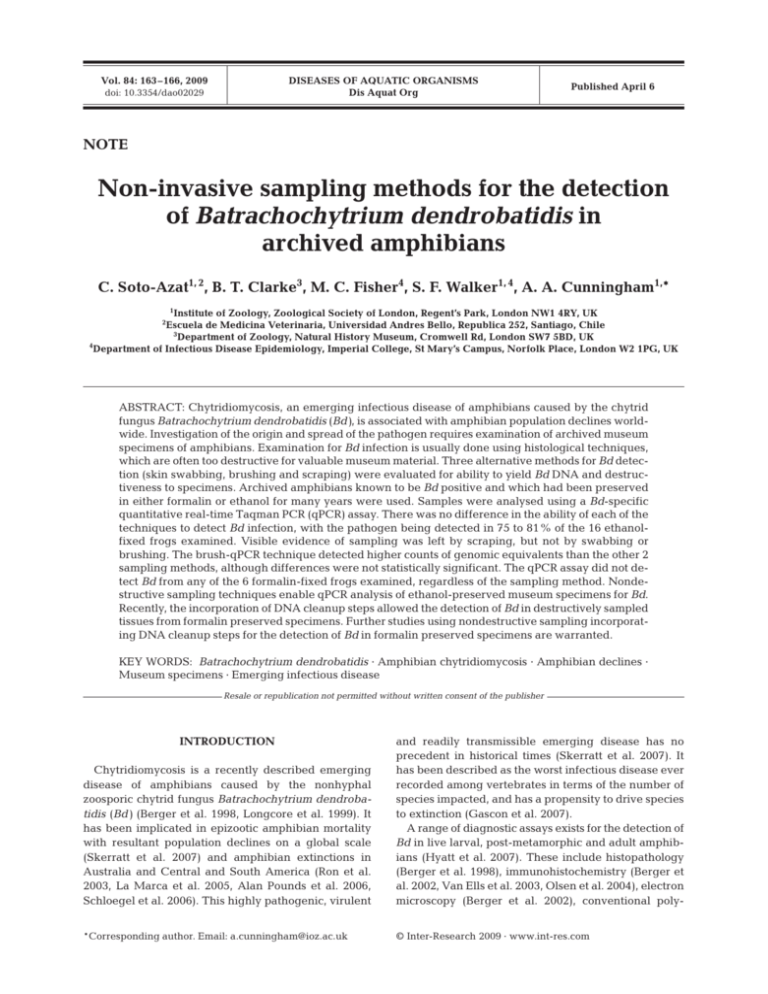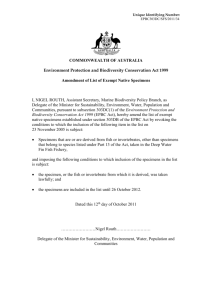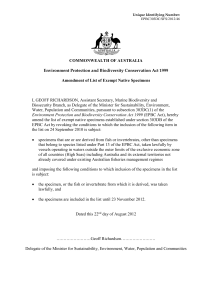Disease of Aquatic Organisms 84:163
advertisement

DISEASES OF AQUATIC ORGANISMS Dis Aquat Org Vol. 84: 163–166, 2009 doi: 10.3354/dao02029 Published April 6 NOTE Non-invasive sampling methods for the detection of Batrachochytrium dendrobatidis in archived amphibians C. Soto-Azat1, 2, B. T. Clarke3, M. C. Fisher4, S. F. Walker1, 4, A. A. Cunningham1,* 1 Institute of Zoology, Zoological Society of London, Regent’s Park, London NW1 4RY, UK Escuela de Medicina Veterinaria, Universidad Andres Bello, Republica 252, Santiago, Chile 3 Department of Zoology, Natural History Museum, Cromwell Rd, London SW7 5BD, UK 4 Department of Infectious Disease Epidemiology, Imperial College, St Mary’s Campus, Norfolk Place, London W2 1PG, UK 2 ABSTRACT: Chytridiomycosis, an emerging infectious disease of amphibians caused by the chytrid fungus Batrachochytrium dendrobatidis (Bd), is associated with amphibian population declines worldwide. Investigation of the origin and spread of the pathogen requires examination of archived museum specimens of amphibians. Examination for Bd infection is usually done using histological techniques, which are often too destructive for valuable museum material. Three alternative methods for Bd detection (skin swabbing, brushing and scraping) were evaluated for ability to yield Bd DNA and destructiveness to specimens. Archived amphibians known to be Bd positive and which had been preserved in either formalin or ethanol for many years were used. Samples were analysed using a Bd-specific quantitative real-time Taqman PCR (qPCR) assay. There was no difference in the ability of each of the techniques to detect Bd infection, with the pathogen being detected in 75 to 81% of the 16 ethanolfixed frogs examined. Visible evidence of sampling was left by scraping, but not by swabbing or brushing. The brush-qPCR technique detected higher counts of genomic equivalents than the other 2 sampling methods, although differences were not statistically significant. The qPCR assay did not detect Bd from any of the 6 formalin-fixed frogs examined, regardless of the sampling method. Nondestructive sampling techniques enable qPCR analysis of ethanol-preserved museum specimens for Bd. Recently, the incorporation of DNA cleanup steps allowed the detection of Bd in destructively sampled tissues from formalin preserved specimens. Further studies using nondestructive sampling incorporating DNA cleanup steps for the detection of Bd in formalin preserved specimens are warranted. KEY WORDS: Batrachochytrium dendrobatidis · Amphibian chytridiomycosis · Amphibian declines · Museum specimens · Emerging infectious disease Resale or republication not permitted without written consent of the publisher Chytridiomycosis is a recently described emerging disease of amphibians caused by the nonhyphal zoosporic chytrid fungus Batrachochytrium dendrobatidis (Bd) (Berger et al. 1998, Longcore et al. 1999). It has been implicated in epizootic amphibian mortality with resultant population declines on a global scale (Skerratt et al. 2007) and amphibian extinctions in Australia and Central and South America (Ron et al. 2003, La Marca et al. 2005, Alan Pounds et al. 2006, Schloegel et al. 2006). This highly pathogenic, virulent and readily transmissible emerging disease has no precedent in historical times (Skerratt et al. 2007). It has been described as the worst infectious disease ever recorded among vertebrates in terms of the number of species impacted, and has a propensity to drive species to extinction (Gascon et al. 2007). A range of diagnostic assays exists for the detection of Bd in live larval, post-metamorphic and adult amphibians (Hyatt et al. 2007). These include histopathology (Berger et al. 1998), immunohistochemistry (Berger et al. 2002, Van Ells et al. 2003, Olsen et al. 2004), electron microscopy (Berger et al. 2002), conventional poly- *Corresponding author. Email: a.cunningham@ioz.ac.uk © Inter-Research 2009 · www.int-res.com INTRODUCTION 164 Dis Aquat Org 84: 163–166, 2009 merase chain reaction (PCR) assay (Annis et al. 2004) and quantitative real-time Taqman PCR (qPCR) assay (Boyle et al. 2004). In order to determine the time and location of the emergence or introduction of this pathogen in different regions worldwide, it is important to examine archived specimens housed in museums and research institutions. Histopathology and immunohistochemistry are usually carried out to diagnose Bd infection from archived amphibians (e.g. Weldon et al. 2004, Ouellet et al. 2005), although recently, Walker et al. (2008) used qPCR to detect Bd infection in skin samples removed from formalin-fixed amphibian specimens. For each of these techniques, however, destructive sampling of specimens is necessary as toe clips or excised skin from the pelvic patch, hind limbs or the interdigital webbing are required (Green & Kagarise Sherman 2001, Lips et al. 2003, Puschendorf 2003, Weldon et al. 2004, Ouellet et al. 2005, Speare & Berger 2005, Walker et al. 2008), rendering these techniques unsuitable for the study of valuable museum specimens. When compared with histopathology and immunohistochemistry, qPCR has been demonstrated to be faster and to have higher sensitivity, repeatability and reproducibility, mainly because of its ability to detect the chytrid fungus at lower concentrations and at earlier stages of infection (Boyle et al. 2004, Kriger et al. 2006, Hyatt et al. 2007). Also, when compared to conventional PCR, qPCR is faster, more sensitive and able to give objective, accurate quantification of unknowns (Annis et al. 2004, Boyle et al. 2004, Kriger et al. 2006). In the present study, we investigated the use of 3 alternative, non-invasive methods to sample archived amphibians for the detection of Bd using qPCR assay. We compared the ability of each method to detect Bd infection in known-positive ethanol- and formalin-fixed specimens and assessed the apparent destructiveness of each sampling technique, and hence the likely acceptability of each method to collection curators. MATERIALS AND METHODS Ethanol-fixed amphibians. We examined 14 adult midwife toads Alytes obstetricans and 2 adult fire salamanders Salamandra salamandra, which had been found dead in the wild in Spain between 2003 and 2005 and which had been fixed and preserved in 70% ethanol since collection. All specimens were sampled for Bd detection prior to preservation and all had been diagnosed as being Bd positive using either qPCR testing of unfixed skin or by histopathological examination of formalin-fixed skin (removed and fixed in formalin at the time of carcass collection) (S. F. Walker et al. unpubl. data). These specimens had been stored in ethanol for 2 to 4 yr prior to testing. Formalin-fixed amphibians. We also examined 4 adult Mallorcan midwife toads Alytes muletensis and 2 adult Cape clawed frogs Xenopus gilli which had died with Bd infection in a captive collection. These specimens were originally diagnosed as being infected with Bd using histopathological examination or by qPCR. The A. muletensis specimens had been stored in 10% neutral buffered formalin for between 12 and 19 yr, while the X. gilli had been stored in formalin for 16 yr prior to testing. Sampling techniques. Each of the preserved amphibians was subjected to each of the 3 sampling methodologies in the following order: (1) swabbing the skin with an MW100 sterile cotton-tipped swab (Medical Wire & Equipment); (2) brushing the skin with an interdental refill tapered brush (3.2 to 6.0 mm; Oral B Laboratories); and (3) scraping the skin with a No. 20 sterile scalpel blade (Swann-Morton). Specimens were firmly sampled with 4 strokes each along their ventral abdomen and pelvis, each ventral hind limb and the plantar surface of each hind foot. In order to minimize the possibility of false positives, each specimen was individually sampled so as to prevent possible cross contamination and a new pair of disposable gloves was used for each specimen. Visual assessment of damage to each specimen was made following each sampling procedure. DNA extraction and real-time PCR assay. After sampling, the cotton tip of the swab, the whole interdental brush or the scraped material obtained were deposited separately in 1.5 ml Eppendorf tubes containing 50 µl of PrepMan Ultra (Applied Biosystems) and between 30 to 40 mg of zirconium/silica beads of 0.5 mm diameter (Biospec Products). DNA was extracted from each sample using the method described by Boyle et al. (2004) and, for each sample, a 1 in 10 aqueous dilution of DNA was stored at –80°C until processing. The diluted nucleic acid extracts were subsequently analysed using a Bd-specific qPCR assay of the ITS1/5.8S ribosomal DNA region of Bd, using a Prism 7700 Sequence Detection System (Applied Biosystems) (Boyle et al. 2004, Hyatt et al. 2007). For each sample, the diagnostic assay was performed in duplicate, and standards of known Bd zoospore concentrations and negative controls were included with each PCR plate. A sample was considered to be positive when: (1) amplification (i.e. a clearly sigmoid curve) occurred in both replicated PCR reactions, and (2) values > 0.1 genomic equivalents (GE) were obtained from both replicated reactions. Statistical analysis. The GE values obtained for each of the 3 sampling techniques for the ethanol-fixed specimens were compared using the Friedman nonparametric 2-way ANOVA (SPSS 13.0). Zero GE values for the ethanol-fixed specimens were included in the analysis. Soto-Azat et al.: Batrachochytrium dendrobatidis detection in archived amphibians RESULTS Thirteen of the 16 ethanol-fixed specimens were found to be Bd positive using the skin-swabbing technique; both skin-brushing and skin-scraping detected Bd infection in 12 of the ethanol-fixed amphibians, but Bd was not detected in any of the samples taken from the formalin-fixed amphibians. The qPCR results with GE values for each of the 3 sampling techniques used on the ethanol-fixed amphibians are presented in Table 1. The brush-qPCR technique detected higher counts of GE (30 998 ± 27 239 CI (95%)) than either the swab-qPCR (7892 ± 13 805 CI) or the scrape-qPCR (23 783 ± 30 417 CI) methods, but this difference was not statistically significant (Friedman test; p = 0.29). Neither the skin-swabbing nor the skin-brushing technique caused visible damage to any specimen, but the skin-scraping technique caused visible loss of epithelium, which would be considered unacceptable by many museum curators. DISCUSSION Each of the 3 non-invasive sampling techniques used on known Bd positive, ethanol-fixed amphibians provided samples in which Bd DNA could be detected using the qPCR assay. Fourteen of the 16 ethanol-fixed specimens were positive to at least 2 sampling protocols (Table 1). Only specimen AU05117 was negative for all 3 different sampling methods. In 2 specimens, Table 1. Alytes obstetricans and Salamandra salamandra. qPCR results including genomic equivalents (GE) obtained from 14 midwife toads and 2 fire salamanders preserved in 70% ethanol. Samples were obtained by swabbing, brushing or scraping the skin and assayed using Bd-specific qPCR Species Specimen A. obstetricans PY03069 PY03070 PY03071 CN05015 CN05021 CN05023 CN05029 CN05030 CN05031 CN05032 AU05117 AU05120 AU05121 AU05122 S. salamandra PEN05189 PEN05191 Skin swab Result GE + + + + + – + + + + – – + + 174 243 291 349 7 0 19 303 10101 357 0 0 113138 1037 + + 14 234 Skin brush Result GE Skin scrape Result GE + 2154 + 510 + 93 + 696 + 58 – 0 + 3808 + 16387 + 78398 – 1.7 × 10–2 – 0 + 150581 + 99669 + 143599 + 14 – 0 – 0 + 5 + 20 + 144 + 1036 – 2.1 × 10– 3 + 58845 + 1343 – 0 + 227608 + 91273 + 9 – + + + 0 17 6 220 165 Bd was not detected using the skin swab, but it was detected either by both the interdental brush and the skin scrape methods (AU05120) or by the skin scrape method alone (CN05023). This might have been due to the more abrasive nature of the last 2 sampling techniques, possibly detecting intracellular zoosporangia located deeper in the skin layers. In 2 specimens, Bd was detected using the skin swab and by the skin scrape, but not using the interdental brush, while in 3 specimens the skin scrape was the only technique which failed to detect Bd. The specimens were sampled using a swab first, followed by an interdental brush and finally via a skin scrape. It is possible that this sequence of sampling may have influenced the outcomes to some degree. Regardless of the method used to sample the Bdinfected frogs, real-time PCR failed to detect infection in formalin-fixed frogs. Formaldehyde causes DNA degradation and cross-linking, inhibiting the PCR reaction, and these changes occur to an increasing degree the longer the period of fixation (Miething et al. 2006). This apparent incapacity of the qPCR assay prevents the widespread use of this diagnostic method for museum amphibians that have been stored in formalin. Nevertheless, new DNA extraction protocols from formaldehyde-fixed tissue have been developed, including one for the PCR detection of amphibian ranaviruses (Kattenbelt et al. 2000). Recently, Bd DNA from formalin-fixed amphibians (Alytes nuletensis and Xenopus gilli) was amplified from skin samples using the qPCR assay applied in the current study (Walker et al. 2008). Walker et al. (2008) purified skin samples using the Qiagen DNeasy blood and tissue DNA extraction kit (Qiagen) prior to DNA amplification (see supplementary information in Walker et al. 2008). Based on these findings, a protocol for PCR-based detection of Bd should include a DNA-cleanup stage prior to qPCR amplification. This modification might increase the usefulness of qPCR for the detection of Bd infection in archived amphibians. Sampling archived amphibians in museums for Bd infection can be problematic, partly because of an understandable reluctance of institutions to permit the destructive sampling of their specimens. Neither the skin swabbing nor the skin brushing techniques used in the current study left visible signs of sampling. To date, the swab-qPCR technique is the preferred method to diagnose the chytrid fungus from live amphibians (Kriger et al. 2006). Although no statistically significant difference in the GE values was detected by the sampling methods used, the interdental brush technique is a modification of the swabbing technique which appears to have the ability to detect a higher GE than either the skin-swab or the skin-scraping methods. The skin-brushing technique, therefore, 166 Dis Aquat Org 84: 163–166, 2009 might be more likely to detect Bd in specimens with low levels of infection, particularly when compared to the other nondestructive (skin-swabbing) technique, which gave the lowest GE values. It is possible that the apparent increased harvesting of Bd by skin brushing would become statistically significant with a larger sample size. Also, the brush-qPCR method has been used to successfully detect Bd DNA infection of the oral discs of an archived, ethanol-fixed Xenopus laevis tadpole (C. Soto-Azat unpubl. obs.). We therefore recommend the skin-brushing technique for the nondestructive sampling of fixed amphibian specimens, including museum reference specimens. Interpretation and use of the results would, however, need to consider the collection, preservation and storage history of the specimens tested. For example, fixative might be changed from formalin to ethanol over time, or a mixture of Bd positive and Bd negative specimens might have been stored together possibly resulting in crosscontamination. The amplification of Bd DNA from the skin of formalin-fixed amphibians has been demonstrated by Walker et al. (2008) with the incorporation of DNA cleanup steps. It is possible that the nondestructive skin-brushing technique would also be successful for formalin-fixed specimens if DNA cleanup steps are adopted. The interdental brush method described here would also be likely suitable for the nondestructive sampling of museum specimens for host or pathogen DNA for other purposes. ➤ ➤ ➤ ➤ ➤ ➤ ➤ ➤ ➤ ➤ Acknowledgements. This study was carried out in partial fulfillment of the Wild Animal Health MSc degree (by C.S.) at the Royal Veterinary College and the Zoological Society of London. The authors thank J. Poynton, M. W. Perkins, T. W. J. Garner and J. Bosch for assistance and valuable comments. We also thank J. A. O. Valls, G. Garcia and S. Hole for the specimens of Alytes muletensis and Xenopus gilli. ➤ LITERATURE CITED ➤ ➤ Alan Pounds J, Bustamante MR, Coloma LA, Consuegra JA ➤ ➤ ➤ ➤ and others (2006) Widespread amphibian extinctions from epidemic disease driven by global warming. Nature 439:161–167 Annis SL, Dastoor FP, Ziel H, Daszak P, Longcore JE (2004) A DNA-based assay identifies Batrachochytrium dendrobatidis in amphibians. J Wildl Dis 40:420–428 Berger L, Speare R, Daszak P, Green DE and others (1998) Chytridiomycosis causes amphibian mortality associated with population declines in the rain forests of Australia and Central America. Proc Natl Acad Sci USA 95: 9031–9036 Berger L, Hyatt AD, Olsen V, Hengstberger SG and others (2002) Production of polyclonal antibodies to Batrachochytrium dendrobatidis and their use in an immunoperoxidase test for chytridiomycosis in amphibians. Dis Aquat Org 48:213–220 Boyle DG, Boyle DB, Olsen V, Morgan JAT, Hyatt AD (2004) Rapid quantitative detection of chytridiomycosis (Batrachochytrium dendrobatidis) in amphibian samples using Editorial responsibility: Alex Hyatt, Geelong, Victoria, Australia ➤ ➤ ➤ real-time Taqman PCR assay. Dis Aquat Org 60:141–148 Gascon C, Collins JP, Moore RD, Church DR, McKay JE, Mendelson JR III (eds) 2007 Amphibian conservation action plan. IUCN/SSC Amphibian Specialist Group. Gland, Switzerland and Cambridge, p 59 Green DE, Kagarise Sherman C (2001) Diagnostic histological findings in Yosemite toads (Bufo canorus) from a die-off in the 1970s. J Herpetol 35:92–103 Hyatt AD, Boyle DG, Olsen V, Boyle DB and others (2007) Diagnostic assays and sampling protocols for the detection of Batrachochytrium dendrobatidis. Dis Aquat Org 73: 175–192 Kattenbelt JA, Hyatt AD, Gould AR (2000) Recovery of ranavirus dsDNA from formalin-fixed archival material. Dis Aquat Org 39:151–154 Kriger KM, Hines HB, Hyatt AD, Boyle DG, Hero JM (2006) Techniques for detecting chytridiomycosis in wild frogs: comparing histology with real-time Taqman PCR. Dis Aquat Org 71:141–148 La Marca E, Lips KR, Lotters S, Puschendorf R and others (2005) Catastrophic population declines and extinctions in neotropical harlequin frogs (Bufonidae: Atelopus). Biotropica 37:190–201 Lips KR, Green DE, Papendick R (2003) Chytridiomycosis in wild frogs from southern Costa Rica. J Herpetol 37:215–218 Longcore JE, Pessier AP, Nichols DK (1999) Batrachochytrium dendrobatidis gen. et sp. nov., a chytrid pathogenic to amphibians. Mycologia 91:219–227 Miething F, Hering S, Hanschke B, Dressler J (2006) Effect of fixation to the degradation of nuclear and mitochondrial DNA in different tissues. J Histochem Cytochem 54: 371–374 Olsen V, Hyatt AD, Boyle DG, Mendez D (2004) Co-localisation of Batrachochytrium dendrobatidis and keratin for enhanced diagnosis of chytridiomycosis in frogs. Dis Aquat Org 61:85–88 Ouellet M, Mikaelian I, Pauli BD, Rodrigue J, Green DM (2005) Historical evidence of widespread chytrid infection in North American amphibian populations. Conserv Biol 19:1431–1440 Puschendorf R (2003) Atelopus varius (harlequin frog) fungal infection. Herpetol Rev 34:355 Ron SR, Duellman WE, Coloma LA, Bustamante MR (2003) Population decline of the Jambato toad Atelopus ignescens (Anura: Bufonidae) in the Andes of Ecuador. J Herpetol 37:116–126 Schloegel LM, Hero JM, Berger L, Speare R, McDonald K, Daszak P (2006) The decline of the sharp-snouted day frog Taudactylus acutirostris: the first documented case of extinction by infection in a free-ranging wildlife species? EcoHealth 3:35–40 Skerratt L, Berger L, Speare R, Cashins S and others (2007) Spread of chytridiomycosis has caused the rapid global decline and extinction of frogs. EcoHealth 4:125–134 Speare R, Berger L (2005) Chytridiomycosis in amphibians in Australia. www.jcu.edu.au/school/phtm/PHTM/frogs/ chyspec. htm (accessed 7 Aug 2007) Van Ells T, Stanton J, Strieby A, Daszak P, Hyatt AD, Brown C (2003) Use of immunohistochemistry to diagnose chytridiomycosis in dyeing poison dart frogs (Dendrobates tinctorius). J Wildl Dis 39:742–745 Walker SF, Bosch J, James TY, Litvintseva AP and others (2008) Invasive pathogens threaten species recovery programs. Curr Biol 18:R853–R854 Weldon C, du Preez LH, Hyatt AD, Muller R, Speare R (2004) Origin of the amphibian chytrid fungus. Emerg Infect Dis 10:2100–2105 Submitted: August 13, 2008; Accepted: January 11, 2009 Proofs received from author(s): March 10, 2009








